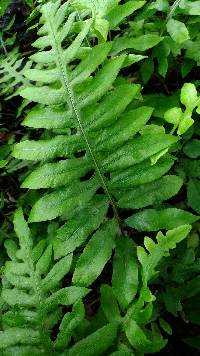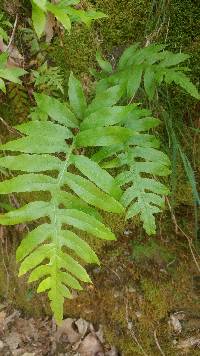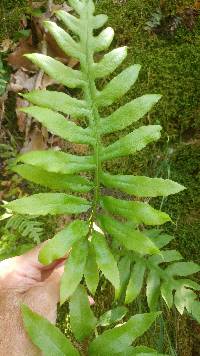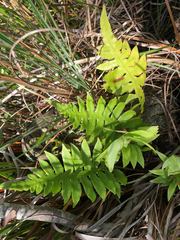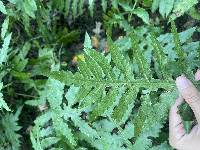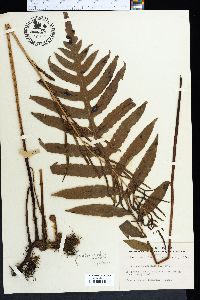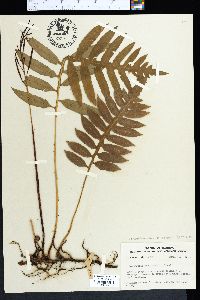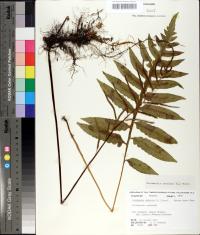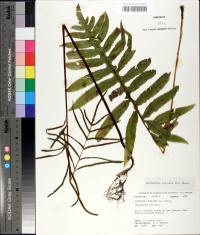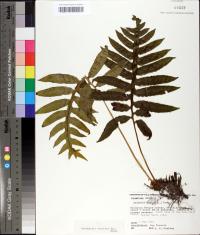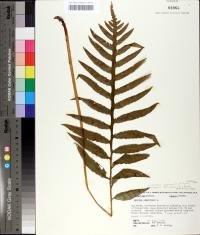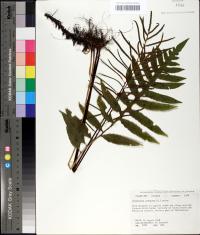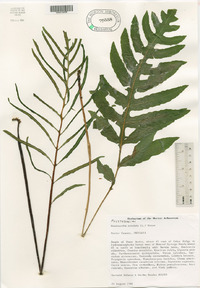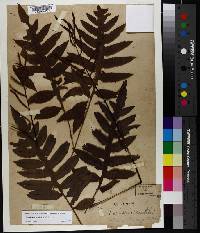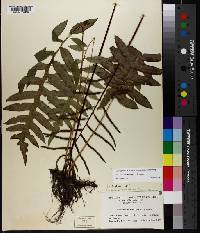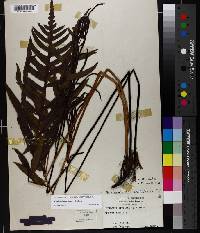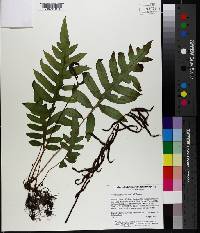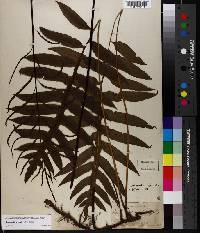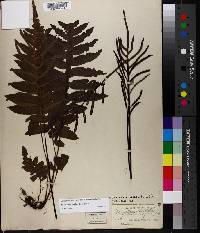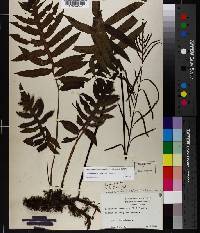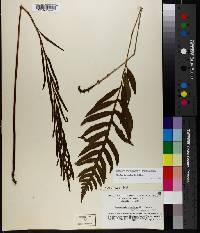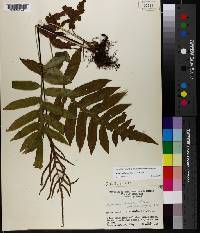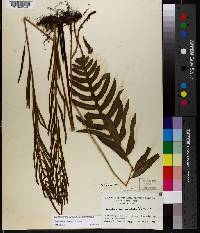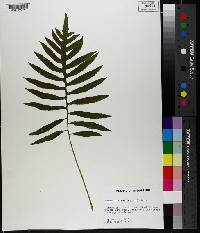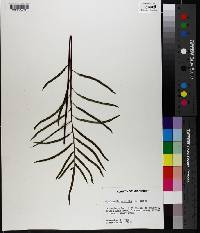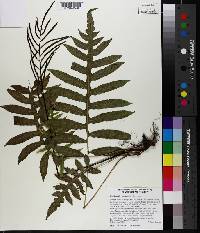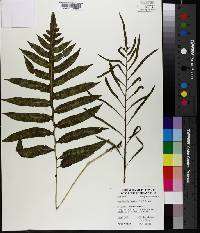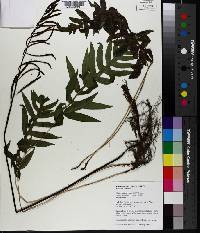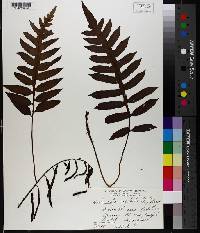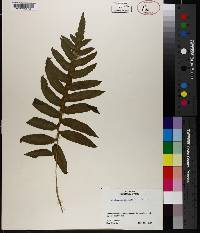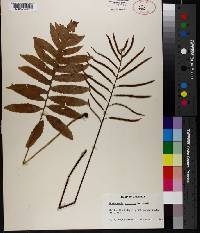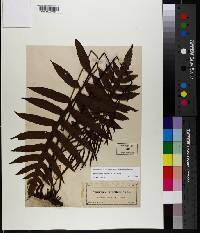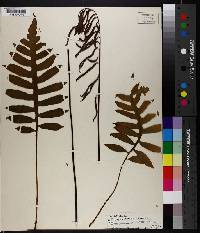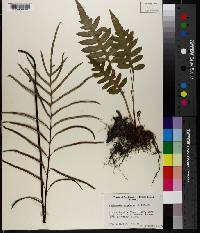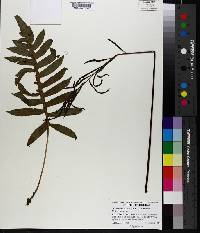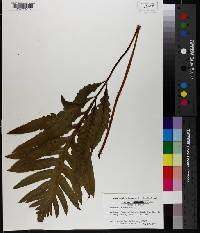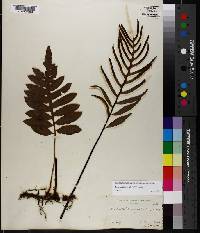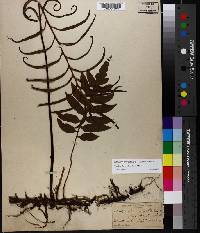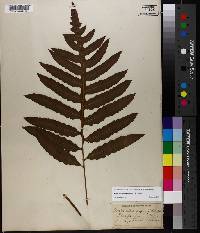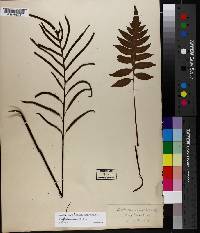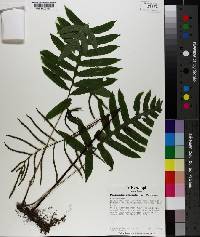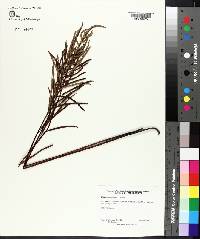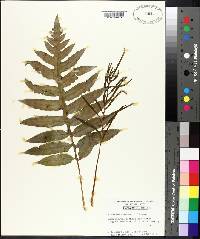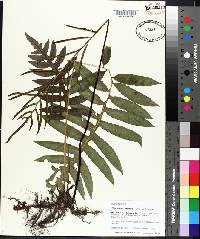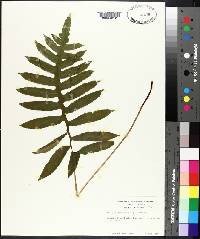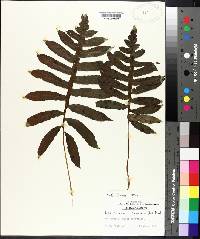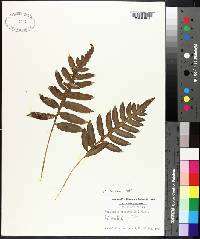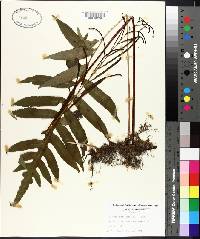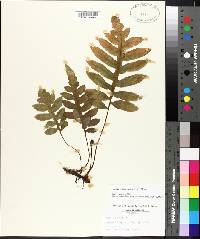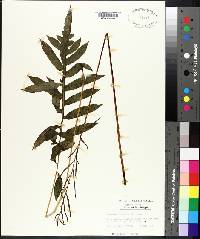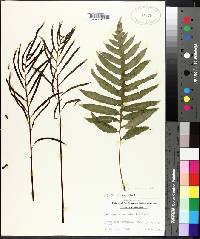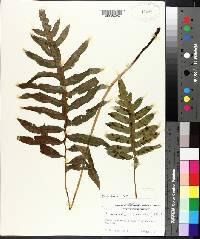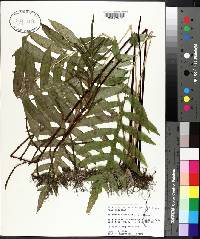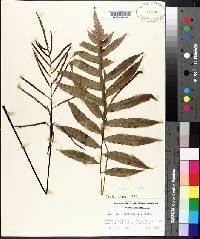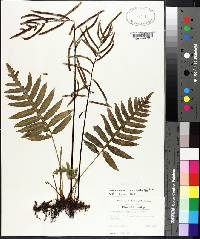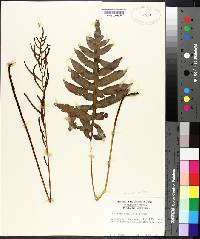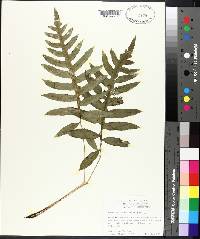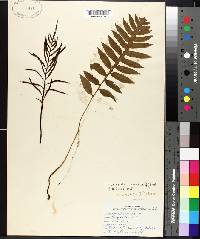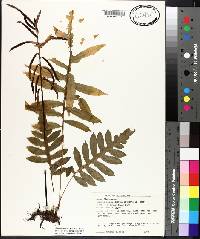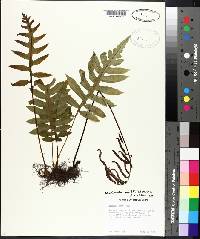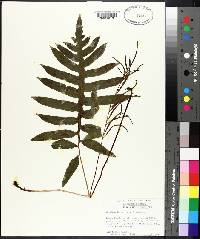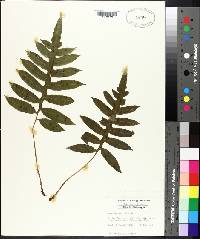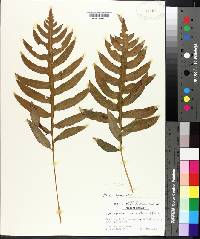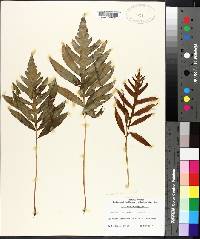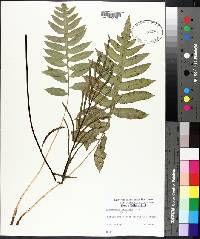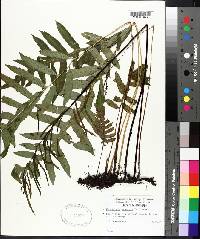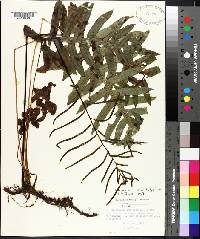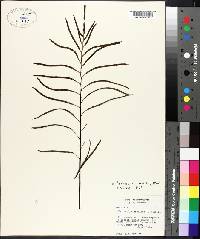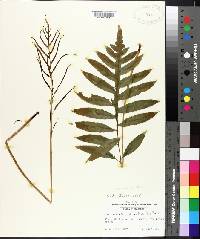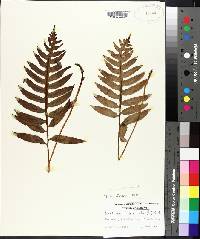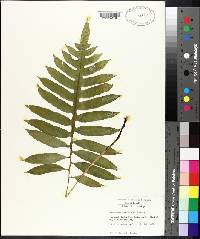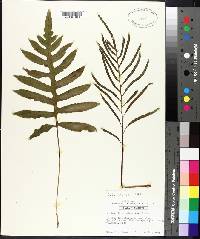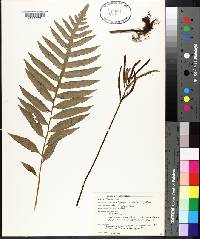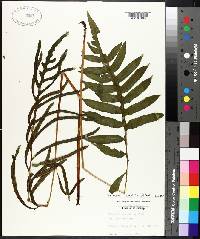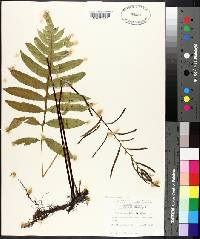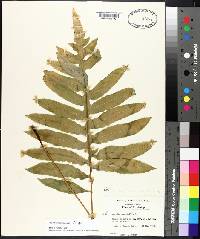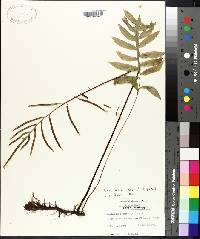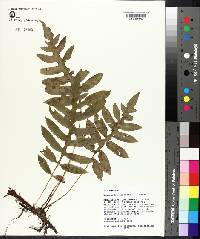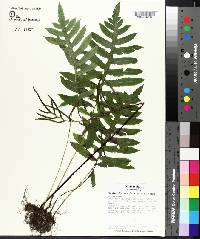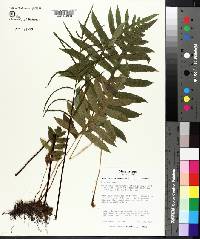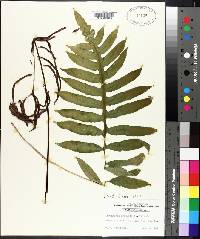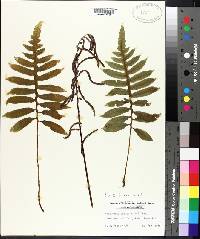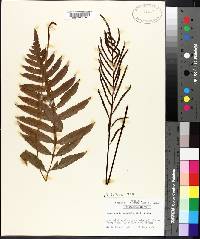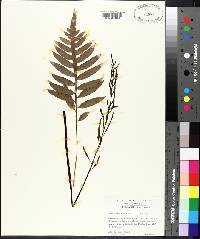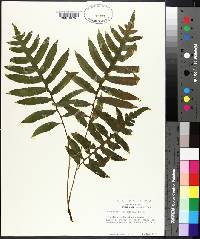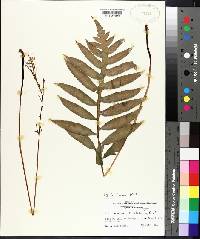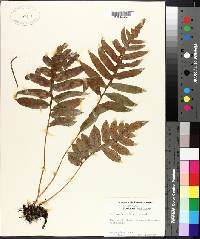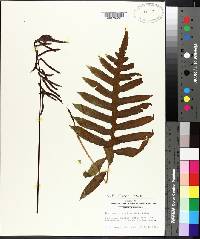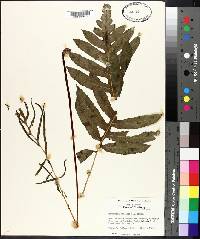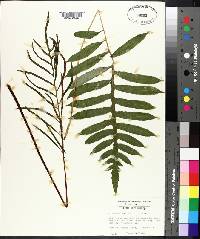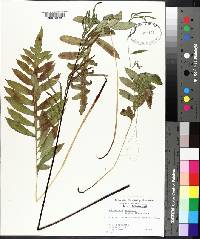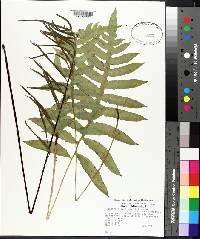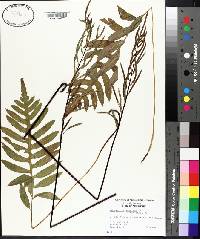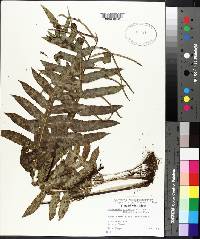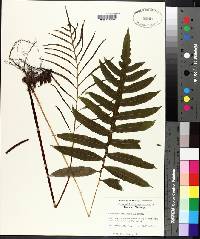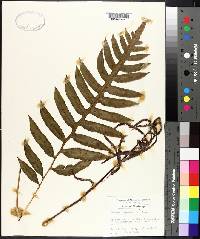Lorinseria areolata
|
|
|
|
Family: Blechnaceae
Netted Chain Fern, more...netted chainfern
[Lorinseria areolata f. onocleoides J. E. Benedict, moreWoodwardia areolata (L.) T. Moore, Woodwardia onocleoides Willd.] |
Stems long-creeping, slender; scales brown, many, broadly lanceolate. Leaves dimorphic, deciduous, few, well separated; sterile leaves 40-58 cm, fertile leaves 49-70 cm. Petiole reddish brown proximally, straw-colored distally; base not swollen, with sparsely set brown scales. Blade bright green, generally lanceolate, scaly-glandular upon emergence but soon glabrate; sterile leaves pinnatifid, 13-26 cm; fertile leaves pinnate, sharply contracted, 20-27 cm. Pinnae not articulate to rachis, arranged in 7-12 alternate pairs; sterile pinnae lanceolate, 3-11 × 1-2.5 cm; fertile pinnae contracted, linear, 3-11 × 0.2-0.5 cm. Veins anastomosing into 2 or more rows of areoles between costae and margin, free only at blade margin. Sori linear-oblong, deeply sunken into blades, nearly occupying full breadth of blade. Indusia ± membranous, lacking thickened cells, tucked under sporangia, not recurving but mostly disintegrating with age. 2 n = 70. Acidic bogs, seeps, and wet woods, rarely on rock of siliceous cliffs and ledges on northern edge of range; 0-600 m; N.S.; Ala., Ark., Conn., Del., Fla., Ga., Ill., Ind., Ky., La., Maine, Md., Mass., Miss., Mo., N.H., N.J., N.Y., N.C., Ohio, Okla., Pa., R.I., S.C., Tenn., Tex., Va., W.Va. Woodwardia areolata is most abundant on the coastal plain of the eastern United States, scattered in the Ouachita and Boston mountains, Ozark and Cumberland plateaus, and the Piedmont, but not in the high Appalachians, the heavy gumbo soils of the Mississippi Valley, or the limestone regions of the Interior Low Plateaus. It apparently has been extirpated in Maine where it is known only from specimens collected in the 1860s. Features such as extreme leaf dimorphism, sunken sori, and expanded persistent indusia set Woodwardia areolata apart from all others in the genus. The existence of closely related transitional species in Asia, however, makes generic segregation uncertain. Those who wish to recognize a monotypic generic segregate based on Woodwardia areolata must coin a new name because Lorinseria C. Presl (1849) is an orthographic variant of Lorinsera Opiz (1839). For a detailed discussion of the ecology and geography of this species, see R. Cranfill (1983). Sterile specimens of this species are sometimes confused with Onoclea sensibilis .
Perennial fern 40 - 70 cm tall Leaves: few, well-separated along rhizome, erect, long-stalked, bright green (sometimes reddish when young), lance-shaped in outline, but pinnately lobed or divided, initially covered with scaly glands, but smooth when unfurled. Two kinds of leaves are produced: sterile and fertile, but all die back in winter. Rhizome: long-creeping, slender (2 - 3.5 mm diameter), covered with many brown, broadly lance-shaped scales. Spores: all of one kind, tiny, single-sectioned (monolete), and kidney-shaped. The spores give rise to the gametophyte (the sexual phase of the plant), which is small, green, heart-shaped, sometimes hairy (with hairs like stalked balls), and sits above the ground. Sterile leaves: shorter than fertile leaves, 13 - 26 cm long, lance-shaped in outline, but deeply pinnately lobed into seven to twelve pairs of alternate, lance-shaped, 3 - 11 cm long, 1 - 2.5 cm wide, finely toothed lobes. The veins of the sterile leaves fork and rejoin to form a netlike pattern, which produces at least two rows of discreet enclosures (areolae) between the center vein and edges of the lobes, thus the veins are only separate (forking but not rejoining) at the very edges. Fertile leaves: longer than sterile leaves, 20 - 27 cm long, lance-shaped in outline, but pinnately divided (compound) into seven to twelve pairs of alternate, very narrow, linear, 3 - 11 cm long, 0.2 - 0.5 cm wide, non-toothed segments (pinnae). Sterile leaf stalks: erect, reddish brown at base (with sparse brown scales), straw-colored upward, varying in length from 15 - 45 cm, but with combined length of stalk and blade in range of 40 - 58 cm (shorter than fertile leaves). Fertile leaf stalks: erect, shiny purple-black, varying in length from 22 - 50 cm, but with combined length of stalk and blade in range of 49 - 70 cm (longer than sterile leaves). Similar species: Woodwardia areolata is quite different from all other species in the genus due to extreme differences in leaf shape between sterile and fertile leaves (dimorphic leaves), the sunken sori (clusters of sporangia), and an expanded indusium (tissue flap associated with sori). Sterile plants may be confused with Onoclea sensibilis, but that species has the leaf divisions (pinnae) arranged opposite not alternate, the leaf edges are non-toothed though often wavy-edged, and the bases of the leaf stalks are obviously swollen. Our more common species of Woodwardia, W. virginica, can be distinguished by the swollen base of the leaf stalks; leaves that are glandular, all the same shape, and may appear pinnately compound two times (the final divisions not fully divided, just deeply lobed); and the veins only join together to form discreet enclosures (areolae) directly next to the pinnae "midribs" (costae) and lobe midvein, with the veins separate the majority of their length to the blade edges. Habitat and ecology: Incredibly rare, only found a few times in a single locality in Porter County, Indiana. The species has a distribution further south and east of the Chicago Region. Occurence in the Chicago region: native Notes: This rare fern has only been found at a single locale in the Chicago Region, and aside from an extinct population that used to occur in Van Buren County, Michigan, this is the most northern sighting in a non-coastal locality. The species is most common along the coastal plain of the eastern United States. The Chicago Region has many coastal plain disjuncts in its flora. Surprisingly, this fern was just discovered in the area in the late 1980's (Swink and Wilhelm 1994). Author: The Field Museum Rhizome 2-3.5 mm thick; lvs dimorphic, 3-8 dm, the sterile ones with stramineous petiole and deltoid-ovate blade 10-17 cm wide, deeply pinnatifid or nearly pinnate at the base, the segments 7-10 pairs, 1-2 cm wide, finely serrulate, net-veined with several series of areoles, but the veins free at the margin; fertile lvs surpassing the sterile, with shining, purple-black petiole, the segments narrowly linear, with a single series of areoles along the costa; indusia linear, 4-8 mm, opening tardily and not reflexed in age; 2n=70. Swamps and wet woods in acid soil; N.S. to n. Fla., w. to Mich., Mo., and e. Tex., commonest on the coastal plain. (Lorinseria a.) Gleason, Henry A. & Cronquist, Arthur J. 1991. Manual of vascular plants of northeastern United States and adjacent Canada. lxxv + 910 pp. ©The New York Botanical Garden. All rights reserved. Used by permission. From Flora of Indiana (1940) by Charles C. Deam Indiana Coefficient of Conservatism: C = 6 Wetland Indicator Status: OBL |


